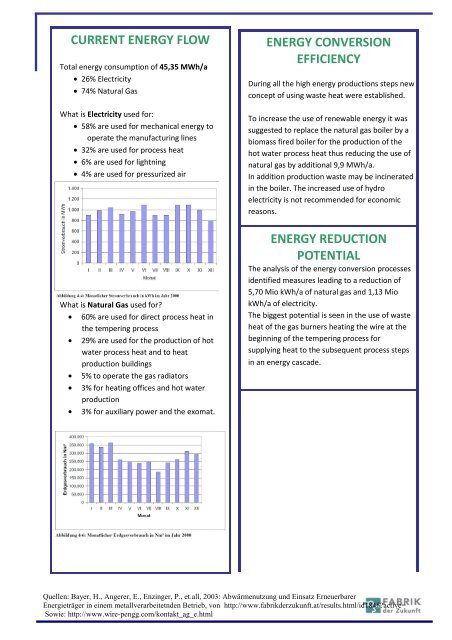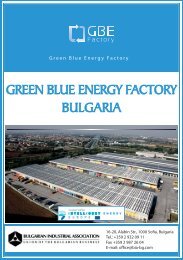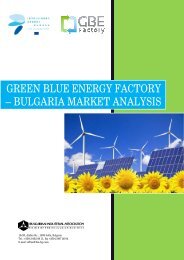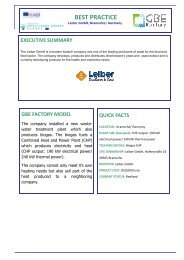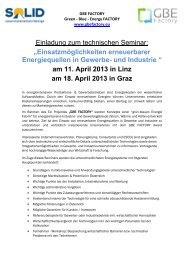Best Practice Pengg - GBEfactory
Best Practice Pengg - GBEfactory
Best Practice Pengg - GBEfactory
Create successful ePaper yourself
Turn your PDF publications into a flip-book with our unique Google optimized e-Paper software.
CURRENT ENERGY FLOW<br />
Total energy consumption of 45,35 MWh/a<br />
• 26% Electricity<br />
• 74% Natural Gas<br />
What is Electricity used for:<br />
• 58% are used for mechanical energy to<br />
operate the manufacturing lines<br />
• 32% are used for process heat<br />
• 6% are used for lightning<br />
• 4% are used for pressurized air<br />
What is Natural Gas used for?<br />
• 60% are used for direct process heat in<br />
the tempering process<br />
• 29% are used for the production of hot<br />
water process heat and to heat<br />
production buildings<br />
• 5% to operate the gas radiators<br />
• 3% for heating offices and hot water<br />
production<br />
• 3% for auxiliary power and the exomat.<br />
ENERGY CONVERSION<br />
EFFICIENCY<br />
During all the high energy productions steps new<br />
concept of using waste heat were established.<br />
To increase the use of renewable energy it was<br />
suggested to replace the natural gas boiler by a<br />
biomass fired boiler for the production of the<br />
hot water process heat thus reducing the use of<br />
natural gas by additional 9,9 MWh/a.<br />
In addition production waste may be incinerated<br />
in the boiler. The increased use of hydro<br />
electricity is not recommended for economic<br />
reasons.<br />
ENERGY REDUCTION<br />
POTENTIAL<br />
The analysis of the energy conversion processes<br />
identified measures leading to a reduction of<br />
5,70 Mio kWh/a of natural gas and 1,13 Mio<br />
kWh/a of electricity.<br />
The biggest potential is seen in the use of waste<br />
heat of the gas burners heating the wire at the<br />
beginning of the tempering process for<br />
supplying heat to the subsequent process steps<br />
in an energy cascade.<br />
Quellen: Bayer, H., Angerer, E., Enzinger, P., et.all, 2003: Abwärmenutzung und Einsatz Erneuerbarer<br />
Energieträger in einem metallverarbeitetnden Betrieb, von http://www.fabrikderzukunft.at/results.html/id1845?active=<br />
Sowie: http://www.wire-pengg.com/kontakt_ag_e.html


